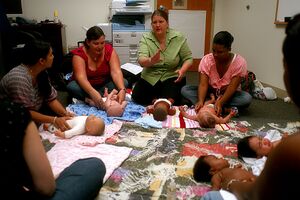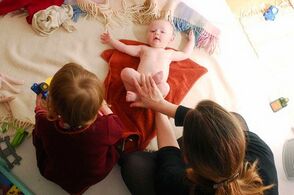Effects of Infant Massage
Introduction[edit | edit source]
Children, classified as infants within their initial 12 months, have been recipients of massage therapy across various cultures from birth. However, the duration, use of oils, and intensity of these massages vary widely between countries. Over time, infant massage has integrated into neonatal intensive care, offering numerous advantages as a part of neonatal physiotherapy. Infant massage in a hospital setting serves as a valuable method to alleviate stress, particularly when they are separated from their parents. Engaging parents in this practice amplifies its positive effects, prompting the development of courses tailored for parents interested in learning about it.[1] Hardly any adverse effects were observed, aside from minor rashes, indicating its safe applicability in practice [2].
Benefits of Infant Massage[edit | edit source]
- It may relieve pain, enhance jaundice conditions, and promote weight gain [1]. In a study investigating massage effects on premature infants' growth, it was noted that applying massage techniques resulted in increased total weight and head circumference. However, no impact on length growth was observed. [3]
- Infant massage has beneficial effects on feeding tolerance and neurodevelopment [2].
- It is not only beneficial to infants, but to the parents as well. Those parents who engage in infant massage during neonatal intensive care are reported to be less stressed and depressed. [2] Additionally to these effects, infant massage is associated with maternal confidence growth in the long term [4].
- A study suggests that infant massage leads to brain maturation which has been recorded with electroencephalography (EEG) [5].
- Incorporating infant massage into the bedtime routine proves highly effective in enhancing sleep. It diminishes the time it takes for infants to fall asleep, reduces nighttime awakenings, extends the duration of uninterrupted sleep for infants, improves mothers’ nighttime sleep duration, addresses maternal sleep issues, and additionally, supports breastfeeding until the age of 6 months. [6]
- Infant massage might be beneficial in managing infantile colic as it has soothing effects [7].
- Parental application of infant massage to babies with Down syndrome in a study led to short-term increases in their levels of acceptance, commitment, and awareness of influence [8].
Effects on Parental Attachment[edit | edit source]
Infant massage promotes maternal attachment to infants. Maternal attachment is “a bond that starts with pregnancy, is established between the baby and the mother, and is enjoyed by both parties”. [9]
It's crucial to highlight that fathers are actively involved in learning about infant massage, fostering a stronger bond between them and their infants [10]. Regarding stress reduction and attachment enhancement, there are no significant differences found between fathers and mothers, however, fathers displayed higher levels of distress over time [11].
Techniques[edit | edit source]
Massage involves manipulating body tissues to promote health and alleviate pain through various methods like patting, kneading, and targeted pressure. Meanwhile, infant massage refers to employing human hands to provide tactile stimulation or medium pressure across a newborn's entire body. Additionally, baby massage often integrates other interventions, such as gentle touches on the baby's body or movements involving the opening and closing of their arms and legs. [12][13]
Precautions[edit | edit source]
Before applying infant massage, it's essential to know the following guidelines[13]:
- Prior to starting the massage, it's important to check for any signs of fever or illness.
- Refrain from massaging a baby who has been recently vaccinated within a 72-hour period to avoid any potential interference with the vaccine's effectiveness.
- If there's any uncertainty regarding the baby's health status, it's advisable to seek advice from a healthcare professional before proceeding with the massage.
- Create a comfortable environment for the massage by conducting it in a warm room when the baby is calm, alert, and active. Aim for a duration of 15-30 minutes, ideally 1-2 hours after feeding.
- Ensure that the person giving the massage has clean hands, short nails, and is free of any jewellery that could cause discomfort to the baby.
- In cases where the baby has Miliaria rubra during summer, it's recommended to avoid using oil for the massage. Consider massaging before bathing in summer and after bathing in winter.
- To prevent accidents or falls, always place the baby on the floor during the massage, especially as they become more mobile.
- Never leave the baby unattended on raised surfaces to prevent any potential accidents.
- Engage with the baby by seeking their permission and gently preparing them through communication and touch to ensure they have a pleasant experience during the massage.
Guide for Performing Infant Massage[edit | edit source]
References[edit | edit source]
- ↑ 1.0 1.1 Mrljak R, Arnsteg Danielsson A, Hedov G, Garmy P. Effects of Infant Massage: A Systematic Review. Int J Environ Res Public Health. 2022 May 24;19(11):6378.
- ↑ 2.0 2.1 2.2 Pados BF, McGlothen-Bell K. Benefits of Infant Massage for Infants and Parents in the NICU. Nurs Womens Health. 2019 Jun;23(3):265-271.
- ↑ Erçelik ZE, Doğan P, Bal Yılmaz H. The Effect of Massage on Growth in Premature Babies: A Systematic Review and Meta-Analysis. JOURNAL OF EDUCATION AND RESEARCH IN NURSING. 2022;19(2):191-7.
- ↑ McCarty DB, Willett S, Kimmel M, Dusing SC. Benefits of maternally-administered infant massage for mothers of hospitalized preterm infants: a scoping review. Matern Health Neonatol Perinatol. 2023 May 3;9(1):6.
- ↑ Lai M, D'Acunto G, Guzzetta A, Finnigan S, Ngenda N, Ware RS, Boyd RN, Colditz PB. Infant massage and brain maturation measured using EEG: A randomised controlled trial. Early Hum Dev. 2022 Sep;172:105632.
- ↑ Rezaei R, Sharif-Nia H, nazari r, Beheshti Z, Saatsaz S. The efficacy of massage as a nightly bedtime routine on infant sleep condition and mother sleep quality: A randomized controlled trial. Journal of Neonatal Nursing. 2022;29.
- ↑ Zeevenhooven J, Browne PD, L'Hoir MP, de Weerth C, Benninga MA. Infant colic: mechanisms and management. Nat Rev Gastroenterol Hepatol. 2018 Aug;15(8):479-496.
- ↑ Barbieri-Figueiredo MDC, Van Riper M. Infant massage applied by parents of infants with Down syndrome (DS) increases their levels of acceptance, commitment and awareness of influence. Evid Based Nurs. 2023 Jul;26(3):121.
- ↑ Erçelik ZE, Yılmaz HB. Effectiveness of infant massage on babies growth, mother-baby attachment and mothers' self-confidence: A randomized controlled trial. Infant Behav Dev. 2023 Nov;73:101897.
- ↑ Suchy C, Morgan G, Duncan S, Villar S, Fox F, Rutledge DN. Teaching Father-Infant Massage during Postpartum Hospitalization: A Randomized Crossover Trial. MCN Am J Matern Child Nurs. 2020 May/Jun;45(3):169-175.
- ↑ Hwu LJ, Tzeng YL, Teng YK, Liu SJ. Effects of massage intervention on discharged premature infants' weight, parental stress, and parent-child attachment: A randomized controlled trial. Infant Behav Dev. 2023 Aug;72:101867.
- ↑ Field T. Pediatric Massage Therapy Research: A Narrative Review. Children (Basel). 2019 Jun 6;6(6):78.
- ↑ 13.0 13.1 Alparslan Ö. Baby Massage and Massage Oils: Are they safe?. Pediatric Practice and Research. 2022; 10(1): 32-37.
- ↑ Cleveland Clinic. Newborn Care and NICU Baby Guide for Parents | Infant Massage. Available from: https://www.youtube.com/watch?v=-93b3bRy1UE [last accessed 28/11/2023]








